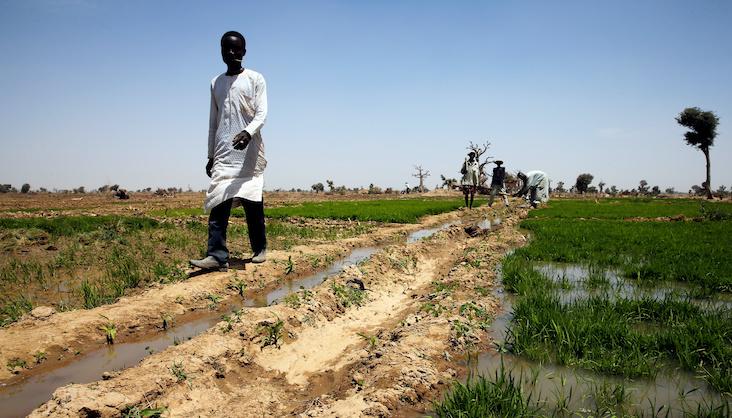Africa-Press – Lesotho. When you think about digital growth in Africa, innovations in finance – not farming – probably spring to mind.
Yet agricultural technology, or agtech, development is rife across the continent – as is the hype surrounding its transformative potential for smallholder farmers.
Smallholders make up 70% of the population of sub-Saharan Africa.
However, despite optimistic promises – including higher incomes, better resilience and improved access to markets and farming inputs – many of these farmers are yet to reap the benefits of the so-called “agtech revolution”.
But while the challenges facing smallholders in this region are complex and manifold, the answer to the agtech problem is relatively simple: farmers must be positioned at the centre of the solution.
Sub-Saharan Africa’s digital sector has boomed in recent years, yet significant barriers still exist for smallholders when it comes to accessing new technologies.
Adequate internet infrastructure has yet to reach those in the most rural areas, while many farmers do not have compatible technology to run new software applications.
And although mobile data costs have fallen across this region, they still remain prohibitively high for many.
Human-centred design is a problem-solving concept, which prioritises user experience by involving the human perspective throughout every step of developing a solution.
But although this principle abounds in the tech circles of Silicon Valley and beyond, it has yet to fully permeate the agricultural sector. It is precisely here that the current issues with agtech in Africa lie.
If digital innovation is to be accessible, affordable and user-friendly for smallholder farmers, then partners and developers cannot simply apply pre-made solutions to circumstances they do not wholly understand.
Just because something works in the Western world, does not guarantee its success within developing-world contexts. Instead, they must engage smallholders in the development process, to ensure they have vital input into the entire procedure – from planning and design to deployment, training and upgrades.
After all, it is these farmers who will be using these tools, so why neglect their vital expertise from the problem-solving process? Producers Direct is a non-profit that has extended its farmer-led approach into agtech development too.
By working directly with farmers and collaborating with specialist partners, the organisation has been able to develop farmer-centric digital tools that revolve around smallholders’ needs and are actually adopted.
For example, the peer-to-peer platform WeFarm – started by Producers Direct in 2010 – is now an award-winning independent entity with two million users.
Designed with the input of farmers – and importantly taking accessibility issues and cost limitations into account – the platform can be used on basic feature phones and operates via SMS. This means that neither a smartphone nor an internet connection is needed, enabling access for everyday smallholders across East Africa.
Critically, as a farmer-to-farmer network, WeFarm enables knowledge to be shared between smallholders rather than through top-down dissemination, which means that relevant solutions for common problems can be pooled.
Through the platform, farmers are able to exchange agronomic practices, market opportunities, weather information, pest warnings and other important, practical updates.
Of course, as WeFarm’s success shows, other factors are imperative to the success of agtech too – such as sensible pricing and clear, context-appropriate communication. But placing farmers at the centre of all these considerations is essential.
For instance, recognising the obstacles smallholder farmers face when getting their products to market – and identifying context-specific solutions – was central to the creation of multi-pronged service tool FarmDirect.
Taking account of the habits, working practices and capacities of smallholders throughout the design process, the service tool enables smallholders to build relationships with distributors, gain improved access to markets and analyse productivity, profit and loss across multiple crops.
By collating on-farm productivity information with historical and real-time weather data from Climate Edge’s NEXO weather stations – and sharing this via 2G networks – FarmDirect enables smallholders to make better business decisions, build resilience and improve crop quality.
Plus, alongside granting farmers access to mobile marketplaces where they can sell their products, the tool produces digital records that they can use for financing applications in order to grow their enterprises.
Vitally, the service is not solely digital; it is also backed by ongoing in-person support from Producers Direct’s farmer-led network.
This enables smallholders to reach training, workshops, financing and markets, as well as play a part in monitoring and improvements. Indeed, farmer involvement throughout the agtech development process is essential – not just at the design or deployment stage, but long after that too.
Once a new technology is rolled out, it is only through ongoing monitoring and user feedback that any issues can be identified and necessary upgrades implemented.
This human-centred, farmer-led approach undoubtedly requires more time and investment than other “one-size-fits-all” methods. But when it comes to achieving sustained impact and long-term benefits for farmers, it works.
For More News And Analysis About Lesotho Follow Africa-Press






